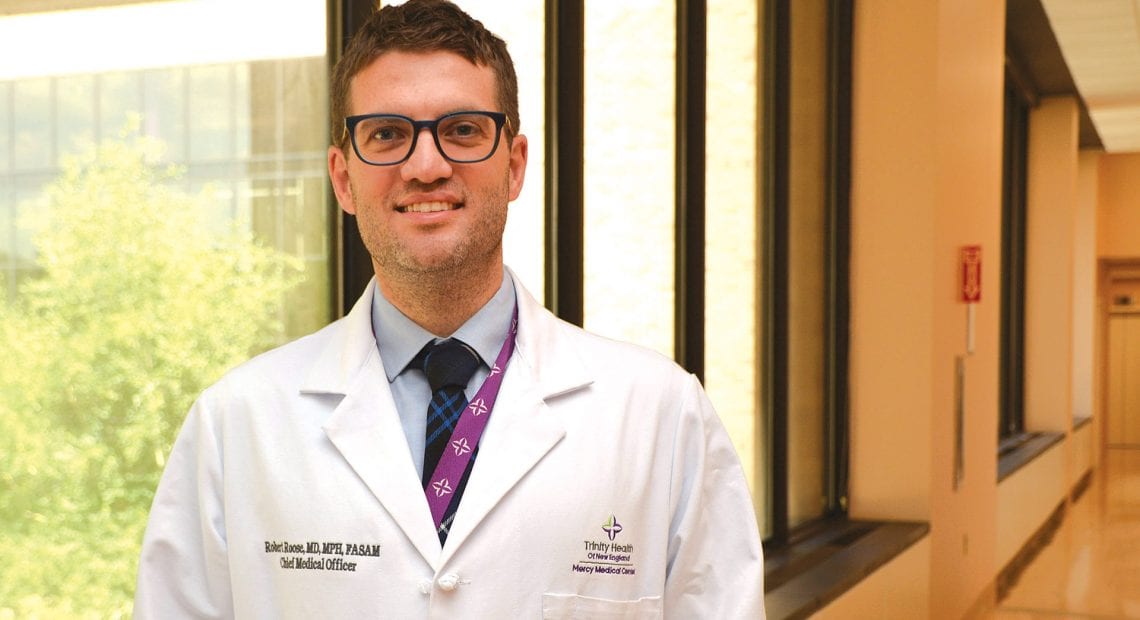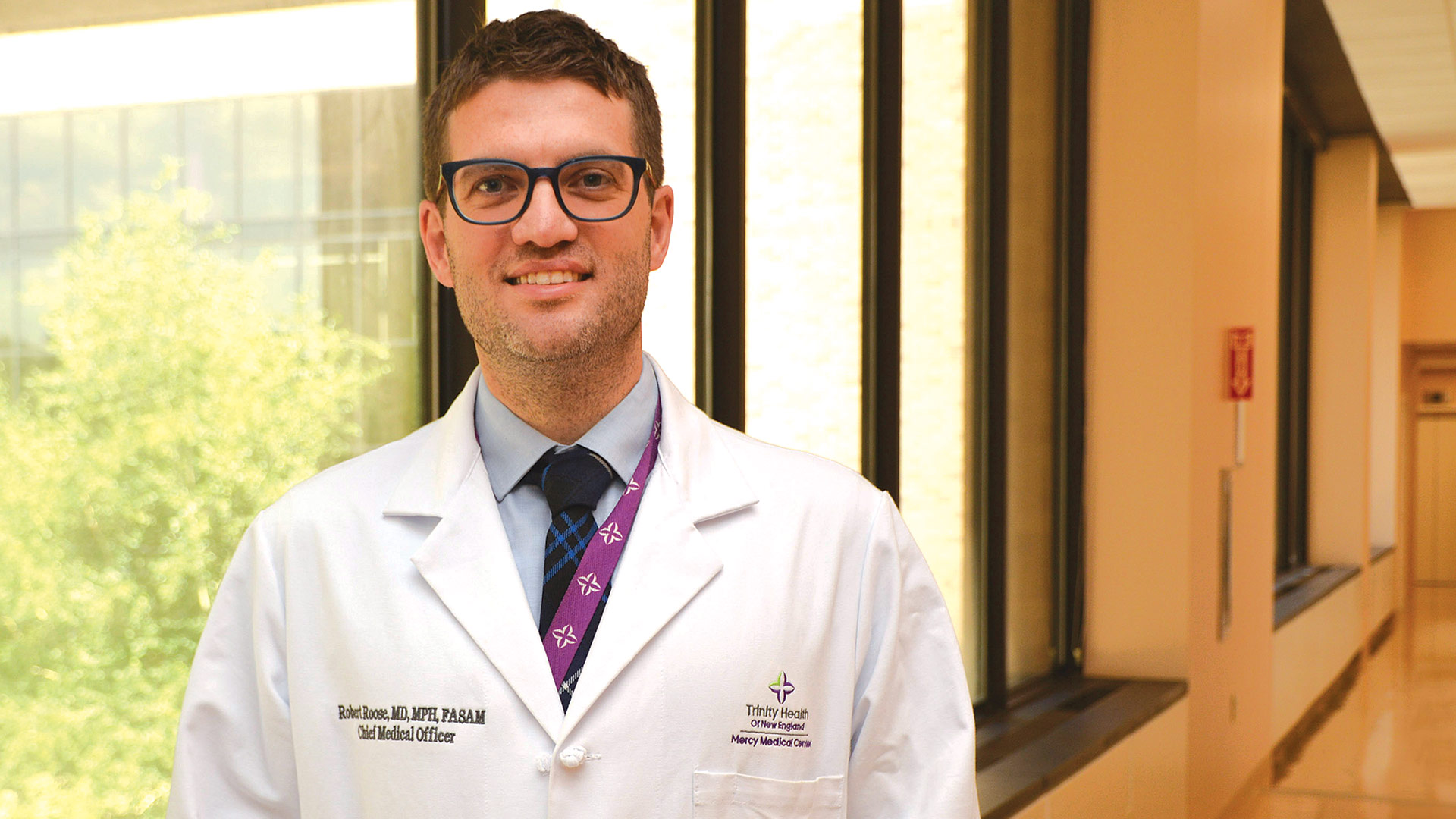
Hospital Leaders Urge Public Not to Let Their Guard Down
A Second Wave?

Dr. Robert Roose says Mercy Medical Center is maintaining its COVID-19 protocols — and hopes the public does so as well.
Dr. Robert Roose knows we’re all sick of this — the mask wearing, the working and learning from home, the lack of fun places to visit … all of it. He gets it. Really.
But here’s the thing.
“The virus has not grown weary of transmitting itself,” said Roose, chief medical officer at Mercy Medical Center. “And it has not waned in the summer months with the hot weather, and it will not wane in the colder months. Our practices need to be just as vigilant as they were in the spring and summer in order to be effective. And we need to continue to be clear, consistent, and fact-based in our messaging.”
We spoke to a few local medical leaders who all cautioned against letting ‘pandemic fatigue’ change behaviors, especially when a vaccine is still not available, infections are rising in many states (the positive-test rate has crept up in Massachusetts, too), and no one knows how the looming flu season will intersect with a still-prevalent coronavirus.
“We aren’t seeing an influx of hospitalized patients like we saw here in the Northeast in March, April, and into May, but we see the data, and it gives all of us some reason for caution, if not broader concern regarding what the colder season might bring. There’s a lot for us still to be cautious about,” Roose told BusinessWest.
That said, local hospitals have learned a lot since the spring as well, he added. “We gained a lot of knowledge we can use to directly improve the health and safety of patients and our colleagues in the community. We have also implemented ways to ensure that care can remain accessible, timely, and safer throughout the pandemic.”
“The virus has not grown weary of transmitting itself. And it has not waned in the summer months with the hot weather, and it will not wane in the colder months.”
Dr. Simon Ahtaridis, chief medical officer at Holyoke Medical Center, said shortages of key supplies in the spring — not just personal protective equipment (PPE), but reagent and transport medium for test kits — led to reviews of processes that will leave hospitals more prepared if a second wave does ensue.
“This virus is unpredictable, and a lot of our early conclusions didn’t bear out,” he said. “We didn’t have lot of experience with this particular virus — how it behaves, how it’s contracted. There was a lot of back and forth in the scientific community on how to best handle it.”
While the medical community saw a great deal of variability in protocols, the goal was always to keep patients — and the community at large — safe. That’s still the case, Ahtaridis said, but part of the challenge is encouraging them to do their part.
Dr. Estevan Garcia
“It’s clear to me that folks are all tired of all the precautions. Until a vaccine is proven effective against COVID, we can’t let our guard down.”
“In terms of thinking about a second wave, a lot of it will depend on the behavior of the public and that virus fatigue. We thought it would be a few weeks, and we’ve seen it drag on and on,” he noted. “The risk is the public starts to lose that caution they’ve been displaying, where they’re not wearing masks, they start to let their guard down. That can lead to a second wave in and of itself.”
Mercy is certainly not letting its guard down, Roose said.
“It’s important to recognize we will continue to maintain the safety protocols in our care that have managed to keep infections much lower than they otherwise would have,” he said. “We’ve managed to reduce and, in some cases, eliminate clusters of infection in hospitals and other settings.”
Local medical leaders hope that trend continues — and they’re doing much more than hoping.
Virus, Meet Virus
That’s because there’s always a new wrinkle — the latest being flu season, which is right around the corner.
“There’s concern about the cooler weather driving everyone indoors, and concern with the flu as well,” said Dr. Estevan Garcia, chief medical officer for Cooley Dickinson Health Care. “We’re beginning to see upper respiratory infections, which are concerns as we move into the fall and winter timeframe. But is it COVID? Is it a cold? Is it the flu? We treat them differently, and we need to make sure we’re isolating the COVID cases.”
Garcia said area hospitals have engaged in a remarkable show of cooperation over the past eight months, communicating with each other on a regular basis and making sure sufficient testing is available. With testing more widely available than it was in the spring, he encouraged not only symptomatic people to be tested, but healthy individuals planning on visiting a grandparent.
He and Ahtaridis both noted that some countries — Australia being the most-cited example — saw much less severe flu seasons than usual earlier this year, and experts credit the widespread use of masks and social-distancing protocols.
“My suspicion is it might be a light influenza season,” Ahtaridis said. “But we are still actively vaccinating patients and making sure patients have information about the flu vaccine, so they’re ready for the season. It might be less severe than last season, but there won’t be zero cases.”
Garcia agreed. “Because of the protections they’ve been taking for COVID, some countries have seen a less severe flu season. But that shouldn’t give people a false sense of security; you should still get a flu shot, use physical distancing, mask wearing, hand washing … all those things are good against the flu.”
He worries, however, that not everyone will recognize the value in continuing COVID protocols.
Dr. Simon Ahtaridis
“My suspicion is it might be a light influenza season. But we are still actively vaccinating patients and making sure patients have information about the flu vaccine, so they’re ready for the season. It might be less severe than last season, but there won’t be zero cases.”
“It’s clear to me that folks are all tired of all the precautions,” he said. “Until a vaccine is proven effective against COVID, we can’t let our guard down. That’s how we have clusters and multiple people getting infected. If we want to get kids back to school and open up businesses again, we’ve got to get through the next wave of late fall and winter and into spring, when, hopefully, there may be some availability of a vaccine.”
The colder weather will pose a challenge, he added, driving people into enclosed spaces for longer periods.
“The fatigue factor is real, but we’ve got to double our efforts to protect ourselves, so masks, hand hygiene, and social distancing are all super important as we move forward,” Garcia said. “One challenge, as we move indoors, will be social distancing at restaurants — these are places we want to continue to stay open, but let’s make sure we’re on top of it and people don’t let their guard down. We need to hold on for the next probably four to six months.”
Roose agreed that pandemic fatigue is a real phenomenon and tough to combat, especially heading into a time of the year usually packed with holiday gatherings. Where people must gather, he said, they need to remember what’s been working in Massachusetts so far.
“We can appeal to people’s sense of generosity and responsibility, their care and love for others — this is something we can do that ultimately can help protect the safety and health of others,” he said. “When you can connect it to something personal or to somebody’s values, that can be a much more effective way to understand the why behind what we’re doing.”
Taking the Long View
These protocols contributed to Massachusetts seeing a relaxation of its infection numbers throughout the summer, but Ahtaridis noted that the positive test rate rose from 2% to 4% recently. “It’s not a huge number, but it’s a doubling of cases, and that probably does reflect changes in behavior and risk tolerance.”
The solution? Do your part.
“Until we have a vaccine, I suspect we’re going to continue with some level of precautions and attention to safety,” he said — and perhaps some of those precautions will never go completely away. He suggested people will look at photos of crowds years from now and be able to tell, by the presence or absence of masks, whether a picture was taken before 2020 or not.
“Even if COVID goes away, even with a vaccine and the advent of better treatments for COVID, I think the public has become more aware of personal space, shared air, and hygiene,” he added. “We’ll probably see some long-term changes.”
With infection numbers still low when compared to some other states, it’s a good time to get vaccinated against the flu, Garcia said — or to get that procedure that was put off in the spring.
“During the spring, people were putting off needed care,” he said, due to both their own concerns and hospitals and other medical facilities shutting down certain treatments to make room for COVID patients. “We’re doing our best to get the message out, make sure people know it’s safe to get care. You shouldn’t put off your care. You don’t want to shut everything down moving forward.”
Roose agreed. “We have processes and procedures in place where we can continue to provide routine, elective, and necessary care while also handling people with COVID,” he said, noting that hospitals, including Mercy, have done a good job of creating separation between patients possibly exposed to coronavirus and those haven’t been exposed. “That’s an important message for the community to hear — that this system has the ability to treat you, even if there’s a second wave of infections.”
While some procedures fall into the cosmetic category, Ahtaridis added, most medical care is not purely elective, which is why hospitals, Holyoke included, have put plenty of thought and resources into making sure they’re safe spaces.
“While the risk never goes down to zero, from a risk-benefit perspective, if you have a medical need, getting it addressed is very important because unmet needs can cause bigger problems down the road,” he said.
“Hospitals tend not to be where people are getting COVID — it tends to be out in the community,” he added. “While not everything is an emergency, most of the things we do are time-sensitive, and if we let medical issues go unaddressed, the consequences can be somewhat dire. We encourage everyone to seek care as appropriate, and do it with confidence.”
And, of course, keep wearing a mask.
Joseph Bednar can be reached at [email protected]






